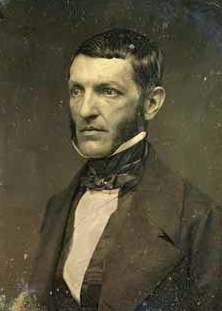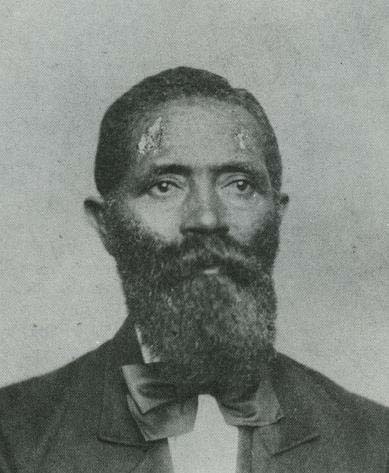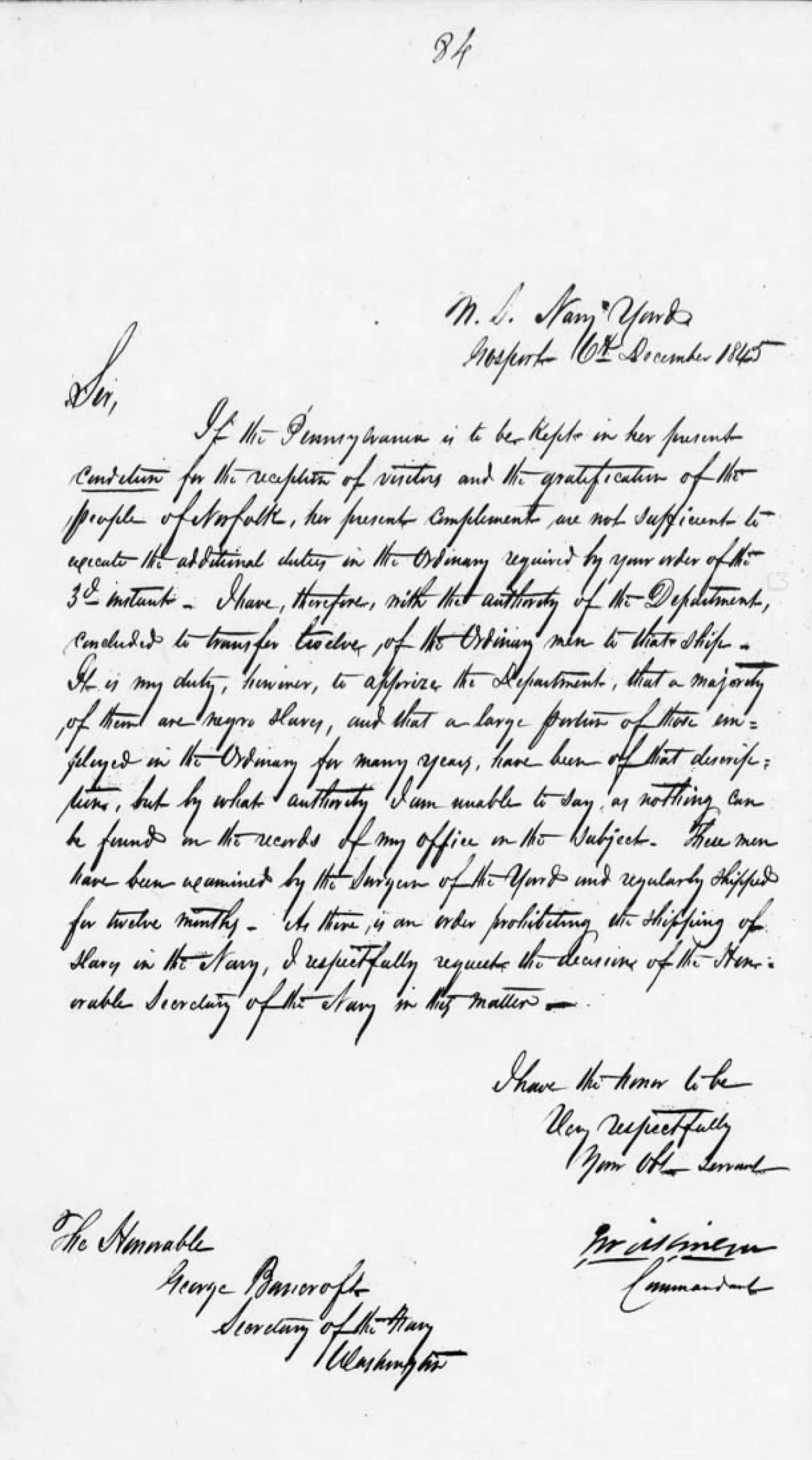Enslaved Laborers at the Gosport Navy Yard, 1845
by John G. M. Sharp“A majority of them are negro slaves...”
Commodore Jesse Wilkerson 7 December 1845
Gosport Navy Yard to Secretary of the Navy George Bancroft
Introduction: The following letter from Commodore Jesse Wilkinson to Secretary of the Navy George Bancroft dated 6 December 1845 confirmed “a large number” of slaves employed in the Gosport (Norfolk) Ordinary.1 Commodore Wilkinson then proceeded to request a decision regarding employment of slaves in view of a previous order banning enslaved labor. Bancroft replied on 7 December 1845, “The slaves were shipped contrary to an order. The Dept. does not justify their enlistment or their retention in the Service – They will be discharged.”2
Discussion: Commodore Wilkinson was correct, there was an order prohibiting “shipping” or enlisting slaves.3 Nonetheless it was an edict with no force. Secretary of the Navy Abel P. Upshur in 1842 in reply to a question from the Speaker of the House of Representatives stated, “There are no slaves in the Navy, except only a few cases in which officers have been permitted to take their personal servants instead of employing them from crews.” Still Upshur carefully noted, “Neither regulations nor usage excludes them as mechanics, laborers, or servants in any branches of the service where such a force is required.”4
The “Ordinary” was designated for ships held in reserve, or for later need. Normally these were vessels that had seen hard service abroad and were awaiting restoration. Others like the older USS Pennsylvania were used to house new sailors, and for the delight of visitors. Due to the small naval appropriations of the era, most large repairs were postponed. To maintain these ships at basic level the navy required a substantial number of enlisted men just to keep them preserved and secure. Hence the need for the seamen assigned to the Gosport Ordinary. These men were stationed on the shipyard either temporarily or for indefinite duration. Both groups were responsible for the maintenance of these laid up ships and the shipyard.
All the men of the Ordinary were under the under the command of the ship yard commandant Commodore Jesse Wilkinson. The Gosport Ordinary included a small group of specialized officers, such as the Purser and Storekeeper. The number of men assigned varied, but consisted of a half dozen officers and up to one hundred enlisted seamen, many of these enslaved. The men were entered at the request of local slaveholders. After their bondsmen were given a physical by the shipyard physician, they were placed on the naval payroll where they deceptively appear as “Landsmen” or “Ordinary Seamen.” In keeping with naval regulations and to sustain the deception, the men were mustered periodically for record keeping and pay purposes. In his letter, Wilkinson acknowledged the men are “negro slaves,” and that a large portion of those employed in the Ordinary had been so “for many years…” His uneasy question to Secretary Bancroft was “by what authority…?” If Bancroft had questioned further, he would have discovered Gosport was hardly unique, for comparable practices existed in the Washington and Pensacola shipyards.5
Commodore Wilkinson clearly knew the Ordinary were largely enslaved laborers, but wanted Bancroft to make the decision less he be held responsible for ending a lucrative practice. At the same time and just a mile from Wilkinson’s office, the twenty-seven year old enslaved laborer and caulker George Teamoh, was suffering ill-treatment.6 He later recounted “I was again hired by the U.S. Government to work in its ordinary service. - was there some two years [1843-1844] on board Ship USS Constitution lying in ordinary off Norfolk Navy Yard ...” Teamoh was even issued a discharge dated 10 September 1845, certifying that he was an “Ordinary Seaman” and was “regularly discharged from the United States Ship Constitution in Ordinary at Navy Yard Norfolk, and from the sea service of the United States.” Teamoh was not fooled, “that branch of the U.S service, so far as hirelings were concerned, was but little different from letting out to a building contractor, varying only in point of punishment - whipping post and cow hide - gang-way and cat-o-nine tails.” Summing up his time at Norfolk ,Teamoh concluded “The government had patronized, and given encouragement to slavery to a greater extent than the great majority of the country has been aware. It had in its service hundreds if not thousands of slaves employed on government works.”7 Bancroft’s call for action was nothing new. In 1839 Wilkinson’s predecessor, Commodore Lewis Warrington, had responded to a similar order to dismiss slaves thus, “I beg leave to state, that no Slave employed in this Yard, is owned by a commissioned officer, but that many are owed by the Master Mechanicks & workmen of the Yard…”8 Teamoh, from bitter experience, knew such orders were of no avail; for as long as slavery was supported by the officers and master mechanics all calls to dismiss the slaves were futile. He wrote slavery was so “interwoven at that time in the very ligaments of the government.”9 He was correct, slavery was intertwined in every aspect of the shipyard and Secretary Bancroft, despite honorable intentions, made no headway before he left office in 1846. As they had repeatedly, the slaveholders prevailed and by 1848 almost one third of the 300 workers at the Gosport (Norfolk) navy yard remained hired slaves.10 Only the Civil War could destroy slavery. In 1861 most Gosport naval officers and white shipyard mechanics took service with the new Southern Confederacy, while blacks like George Teamoh sought freedom and remained steadfast supporters of the Union cause.
Transcription: This transcription was made from digital images of letters and documents received by the Secretary of the Navy, NARA, M125 “Captains Letters” National Archives and Records. In transcribing all passages from the letters and memorandum, I have striven to adhere as closely as possible to the original in spelling, capitalization, punctuation, and abbreviation, superscripts, etc., including the retention of dashes and underlining found in the original. Words and passages that were crossed out in the letters are transcribed either as overstrikes or in notes. Words which are unreadable or illegible are so noted in square brackets. When a spelling is so unusual as to be misleading or confusing, the correct spelling immediately follows in square brackets and italicized type or is discussed in a foot note.
John G. Sharp, 8 March 2019
* * * * * *
U.S. Navy Yard
Gosport 6th December 1845Sir,
If the Pennsylvania is to be kept in her present condition for the reception of visitors and the gratification of the people of Norfolk, her present complement, are not sufficient to execute the additional duties in the Ordinary required by your order of the 3d instant –11 I have, therefore, with the authority of the Department, concluded to transfer twelve of the Ordinary men to that Ship – It is my duty, however to appraise the Department, that a majority of them are negro slaves, and that a large portion of those employed in the Ordinary for many years, have been of that description, but by what authority I am unable to say as nothing can be found in the records of my office on the subject – These men have been examined by the Surgeon of the Yard and regularly Shipped for twelve months – As there is an order prohibiting the shipping of slaves in the Navy, I respectfully request the decision of the Honorable Secretary of the Navy in this matter -
I have the honor to be
Very respectfully
Your obt. Servant
J. Wilkinson
Commandant
The Honorable
George Bancroft
Secretary of Navy
Washington
[Obverse] “Wilkinson ab. slaves in Ord. The slaves were shipped contrary to an order. The Dept. does not justify their enlistment or their retention in the Service – They will be discharged.”“To him: 7 Dec.”


Left: George Bancroft, 1846
Middle: George Teamoh (LOC)
Right: Wilkinson to Bancroft Sec Nav 6 Dec 1845 re Ordinary men majority of them are negro slavesEndnotes:
Names, ranks, dates of naval and marine officers, listed below are unless otherwise specified, from Naval History and Heritage Command Officers Continental and US Navy and Marine Corps 1775 -1900 https://www.history.navy.mil/research/library/online-reading-room/title-list-alphabetically/o/officers-continental-usnavy-mc-1775-1900.html
1 Commodore Jesse Wilkinson USN entered the navy as a Midshipman, 4 July, 1805. He was promoted to Lieutenant, 10 April, 1810, Master Commandant, 18 April, 1818 and Captain, 11 March, 1829. Wilkinson was in command of Gosport Navy Yard from 1843 -1847. He entered the reserved list, on 13 September, 1855. Commodore Wilkinson died 23 March, 1861 and was buried in Norfolk Virginia.George Bancroft (1800 –1891) was an American historian and statesman prominent in promoting secondary education both in his home state, at the national and international level. During his tenure as U.S. Secretary of the Navy, he established the United States Naval Academy at Annapolis in 1845. He was a senior American diplomat in Europe. Among his best-known writings is the magisterial series, History of the United States, from the Discovery of the American Continent. In 1845, in recognition for his support at the previous Democratic convention, Bancroft was appointed to James Polk's cabinet as Secretary of the Navy, serving until 1846, when, for a month, he was acting Secretary of War.
2 Wilkinson to Bancroft, 6 December 1845 NARA M125 “Captains Letters” Letter Received from Captains 1805 -1885, 1 Nov 1845 – 31 Dec 1845, letter number 84, 1-2
3 The Law Reporter Vol VII editor Peleg W. Chandler (Boston: Bradbury, Soden & Co. 1845), 381-382
4 Secretary of the Navy, A.P. Upshur, to the Speaker of the House, 10 August 1842, Exec. Doc. No. 282, 27th Congress, 2nd Session, volume v.
5 The Diary of Michael Shiner Relating to the History of the Washington Navy Yard 1813-1869, Naval History and Heritage Command, 2015, John G. Sharp, editor retrieved 8 March 2019 https://www.history.navy.mil/research/library/online-reading-room/title-list-alphabetically/d/diary-of-michael-shiner.html
Ernest F. Dibble, Antebellum Pensacola and the Military Presence, (Pensacola Series Commemorating the American Revolution Bicentennial 3, Pensacola, FL: Pensacola/Escambia Development Commission, 1974),61-65
6 George Teamoh (1818 – after 1887) was born enslaved in Norfolk, Virginia, worked at the Fort Monroe, the Norfolk Naval Yard and other military installations before the American Civil War, escaped to freedom in New York and moved to Massachusetts circa 1853, and returned to Virginia after the war to became a community leader, member of the Virginia Constitutional Convention of 1868 and then Virginia Senate during the Reconstruction era, and finally an author in his final years. Teamoh's recently published autobiography is remarkable for his clear rebuke of the military's use of slave labor and the federal government's role both in perpetuating slavery and failing to protect newly emancipated blacks.
7 George Teamoh God Made Man Man Made the Slave: The Autobiography of George Teamoh, edited by F.N. Boney, Richard L. Hume and Rafia Zafar (Macon: Mercer University Press, 1990),82-83
8 John G. Sharp A Norfolk Navy Yard Slaveholders Petition to the Secretary of the Navy, June 21, 1839 http://www.usgwarchives.net/va/portsmouth/shipyard/nnysharp6.html
9 Teamoh 84 -85
10 Robert S. Starobin Industrial Slavery in the Old South Oxford ( University Press: Oxford, 1975), 32
11 USS Pennsylvania was a three-decked ship of the line of the United States Navy, rated at 130 guns and named for the state of Pennsylvania. At the time she was the largest United States sailing warship ever built, the equivalent of a first-rate of the British Royal Navy. Authorized in 1816 and launched in 1837, her only cruise was a single trip from Delaware Bay through Chesapeake Bay to the Norfolk Navy Yard. The ship became a receiving ship, and during the Civil War was destroyed.
